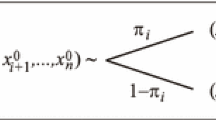Abstract
We present a method to characterize the preferences of a decision maker in decisions with multiple attributes. The approach modifies the outcomes of a multivariate lottery with a multivariate transformation and observes the change in the decision maker’s certain equivalent. If the certain equivalent follows this multivariate transformation, we refer to this situation as multiattribute transformation invariance, and we derive the functional form of the utility function. We then show that any additive or multiplicative utility function that is formed of continuous and strictly monotonic utility functions of the individual attributes must satisfy transformation invariance with a multivariate transformation. This result provides a new interpretation for multiattribute utility functions with mutual utility independence as well as a necessary and sufficient condition that must be satisfied when assuming these widely used functional forms. We work through several examples to illustrate the approach.
Similar content being viewed by others
References
Abbas A.E. (2007) Invariant utility functions and certain equivalent transformations. Decision Analysis 4(1): 17–31
Abbas, A. E., Aczél, J., & Chudziak, J. (2008). Invariance of multiattribute utility functions under shift transformations. Results in Mathematics. doi:10.1007/s00025-007-0266-0.
Aczél J. (1966) Lectures on functional equations and their applications. Academic Press, NY
Arrow, K. J. (1965). The theory of risk aversion. Lecture 2 in aspects of the theory of risk-bearing. Helsinki: Yrjo Jahnssonin Saatio.
Baucells M., Sarin R.K. (2007) Evaluating time streams of income: discounting what?. Theory and Decision 63: 95–120
Dyer J.S., Sarin R. (1982) Relative risk aversion. Management Science 28: 875–886
Howard, R.A. (1967). Value of information lotteries. IEEE Transactions on Systems Science and Cybernetics, SCC-3(1), 24–60.
Howard R.A. (1971) Proximal decision analysis. Management Science 17: 567–601
Keeney R.L., Raiffa H. (1976) Decisions with multiple objectives: preferences and value tradeoffs. John Wiley and Sons, Inc., New York
Matheson J.E., Abbas A.E. (2005) Utility transversality: a value-based approach. Journal of Multicriteria Decision Analysis 13: 229–238
Pfanzagl, J. (1959). A general theory of measurement applications to utility, Naval Research Logistic Quarterly, 6, 283–294.
Pratt J. (1964) Risk aversion in the small and in the large. Econometrica 32: 122–136
Raiffa H. (1968) Decision analysis. Addison-Wesley, Reading, MA
von Neumann J., Morgenstern O. (1947) Theory of games and economic behavior. Princeton University Press, Princeton, NJ
Author information
Authors and Affiliations
Corresponding author
Rights and permissions
About this article
Cite this article
Abbas, A.E. Invariant multiattribute utility functions. Theory Decis 68, 69–99 (2010). https://doi.org/10.1007/s11238-009-9149-z
Received:
Accepted:
Published:
Issue Date:
DOI: https://doi.org/10.1007/s11238-009-9149-z




